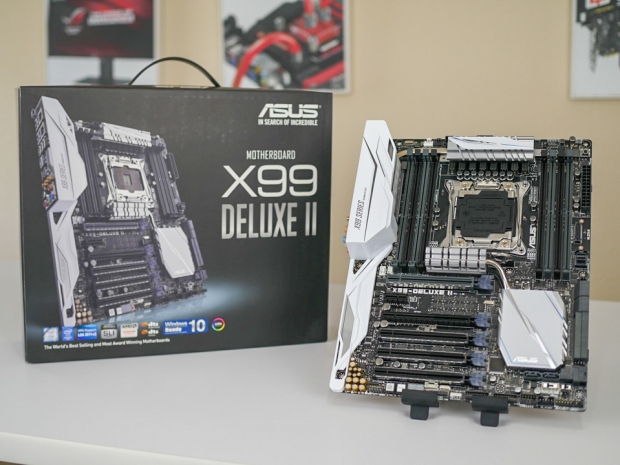The boards come as an anticipated refresh during a time for PC builders when Intel is set to announce new 14-nanometer Skylake CPUs for its high-end desktop (HEDT) enthusiast segment – namely, the Core i7 6800K (six-core), Core i7 6850K (six-core), Core i7 6900K (eight-core) and Core i7 Extreme 6950X (ten-core).
New boards: X99-E, X99-A II, and X99 Deluxe II (along with ROG series Strix X99 Gaming)

Right to left: ASUS X99-E (entry-level), X99-A II (mid-range), X99 Deluxe II (high-end) and ROG Strix X99 Gaming motherboards
In addition to launching the ROG Strix X99 Gaming motherboard, ASUS is also launching the X99-E, the X99-A II, and the X99 Deluxe II – three new boards that will replace the first-generation X99-A / X99-A USB 3.1, and the X99 Deluxe / X99 Deluxe USB 3.1. According to ASUS company officials, these upgrades span multiple categories, including RGB lighting, expansion slot reinforcement, and cooling management.
In the lighting department, while all the new X99 boards have integrated Aura lighting, the X99 Deluxe II, X99-A II, and ROG Strix X99 Gaming also feature a four-pin RGB header for external strips.
In the cooling department, the company's new X99 boards now detect the presence of three-pin DC and four-pin PWM fans automatically to ensure easy and optimal cooling regardless of system payload. They each now include a dedicated header for high-amperage fans, capable of pushing up to 3 amps for maximum airflow.
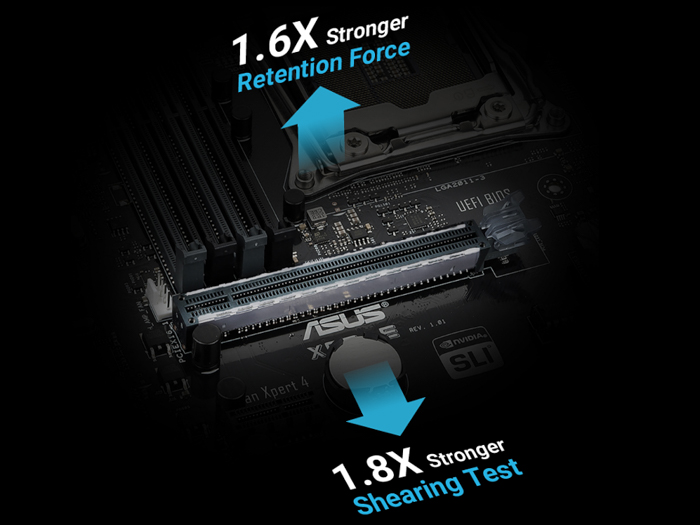
Finally, in terms of PCI-E slot reinforcement, all of the new ASUS X99 Signature motherboards including the ROG Strix X99 Gaming feature the company’s new “SafeSlot” – a redesigned, strengthened PCI-Express slot that uses a new insert-molding process to bind the slot to fortifying metal. The company claims this provides up to 1.6 times more retention and 1.8 times more shearing resistance and is “stronger than anything else on the market.” ASUS says all the new and refreshed X99 motherboards have at least one SafeSlot for the primary PCI-E graphics card, if not more than one.
The refreshed X99 Signature series boards also feature up to dual U.2 and M.2 slots featuring up to 32Gbps of PCI-Express bandwidth, 3x3 802.11ac Wi-Fi, USB 3.1 Type-A and reversible USB 3.1 Type-C. The X99 Deluxe II also bundles the new ASUS ThunderboltEX 3, an add-on expansion card with bidirectional transfer speeds up to 40Gbps.
All except the entry-level X99-E feature ASUS “OC Socket” additional pins
The X99-A II, X99 Deluxe II and ROG Strix X99 Gaming (not the X99-E) all feature ASUS “OC Socket,” the company’s marketing for incorporating extra pins on the CPU socket. This is basically another way of saying that these LGA 2011v3 boards don’t necessarily feature only 2011 pins (see: “Socket 2084”). The reasoning is that Intel’s Haswell-E and upcoming Broadwell-E series chips have more pads than the reference LGA 2011v3 socket design, so ASUS and other companies like Gigabyte (with the GA-X99-SOC Champion and Force series) have added these extra pins to take advantage of subtle changes in voltage dynamics. The company’s ROG website has an in-depth overview of how this technology apparently benefits memory overclocking at lower voltages which can be found here.
X99-E: “Elite without the expense”
The ASUS X99-E is the only new, non-refresh motherboard in the updated X99 series that isn’t a previous design. At a $219 price point, this is the company’s entry-level ATX form factor X99 motherboard right below the X99-A II ($249), the discontinued microATX X99-M WS ($276), the Sabertooth X99 ($299), the ROG Strix X99 Gaming ($339), the X99-Deluxe II ($419), the X99 Rampage V Extreme ($479) and the X99-E WS ($525), in that order.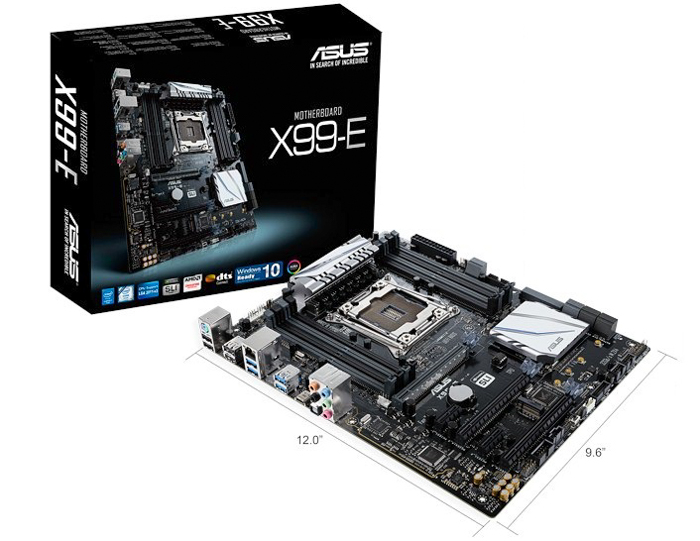
The board supports up to eight memory modules totaling 128GB of DDR4 at 3200MHz memory speeds and features three PCI-Express 3.0 x16 slots. In terms of CPU support, it is fully compatible with existing Haswell-E chips (Core i7 5820K, Core i7 5930K and Core i7 Extreme 5960X) and fully supports upcoming Broadwell-E chips (Core i7 6800K, Core i7 6850K, Core i7 6900K and Core i7 Extreme 6950X).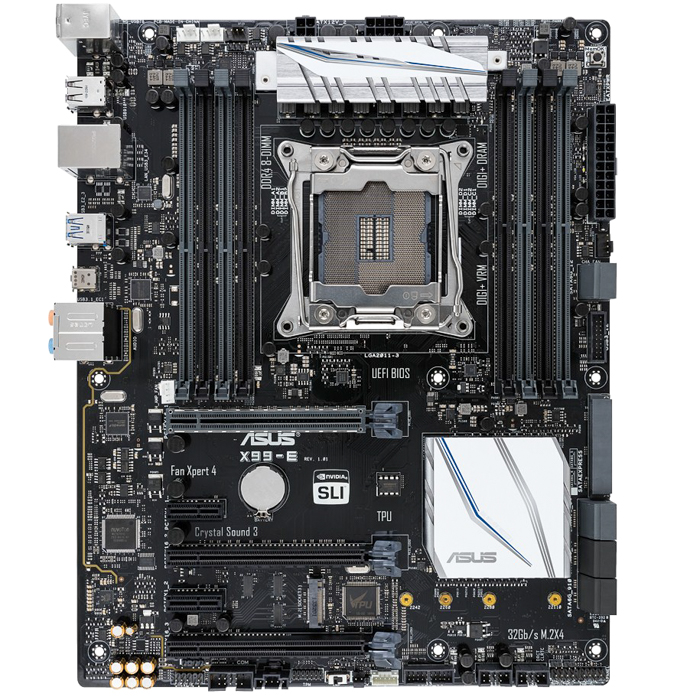
Connectivity options on the new entry-level X99-E include one M.2 Socket 3 Type M slot supporting PCI-E 3.0 x4 AHCI / NVMe drives, one SATA 3.2 Express 1969MB/s port, and eight SATA III 6Gbps ports (two shared with SATA Express). Other components include an Intel I218V Gigabit Ethernet controller, an eight-phase digital voltage regulator (VRM) design and a Thunderbolt header. Unfortunately, this board does not include on-board power and reset buttons.
Regarding the USB input situation – there is one 10Gbps USB 3.1 port using an ASMedia controller on the back panel (Type-C), five USB 3.0 ports controlled by the X99 chipset (one on back panel, four on-board), three USB 3.0 ports using an ASMedia controller (on back panel) and eight USB 2.0 ports controlled by the X99 chipset (four on back panel, four on-board).
In terms of audio, the board includes a Realtek ALC1150 eight-channel audio codec featuring Crystal Sound 3 and uses two separate audio layers on the PCB – separate layers for left and right channels that provide extra interference shielding. The Realtek audio codec features a 112db signal-to-noise ratio (line-out) and 104dB signal-to-noise ratio for stereo input (line-in) along with DTS Connect and Absolute Pitch 192KHz, 24-bit True Blu-ray Disc Lossless Sound. The board also features an optical port on the back panel and uses high-quality premium Japanese capacitors, includes an EMI shield and has a unique “de-pop” circuit that reduces start-up popping noise on audio output signals.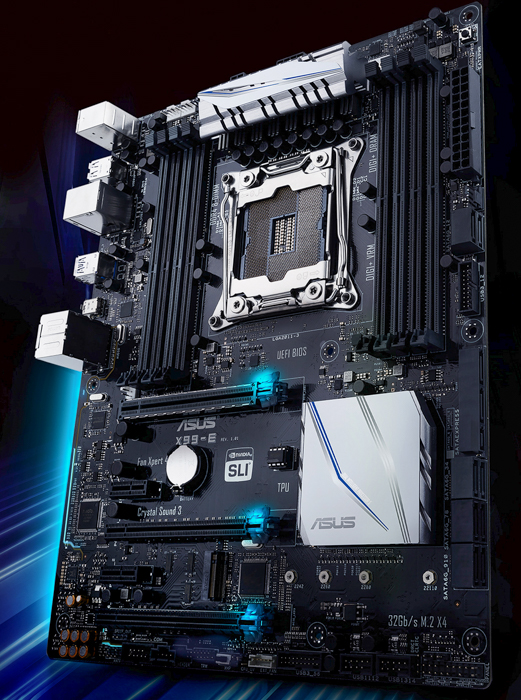
ASUS Aura lighting on PCI-E slot retainers of the X99-E
This board also features ten custom LED effects which can be fine-tuned with ASUS Aura, a lighting control software utility that provides custom lighting for the board’s PCI-E slot retainers and fan headers. It does not, however, include a 4-pin RGB header for additional lighting input (this is offered on the X99-A II, X99 Deluxe II and ROG Strix X99 Gaming models).
The ASUS X99-E is priced at $219, just slightly higher than EVGA's X99 microATX board ($207.50) yet still lower than Gigabyte's GA-X99P-SLI ($249.99). It is not yet available as of launch date but is expected to arrive in retail channels before the end of the month.
X99-A II: “All the things”
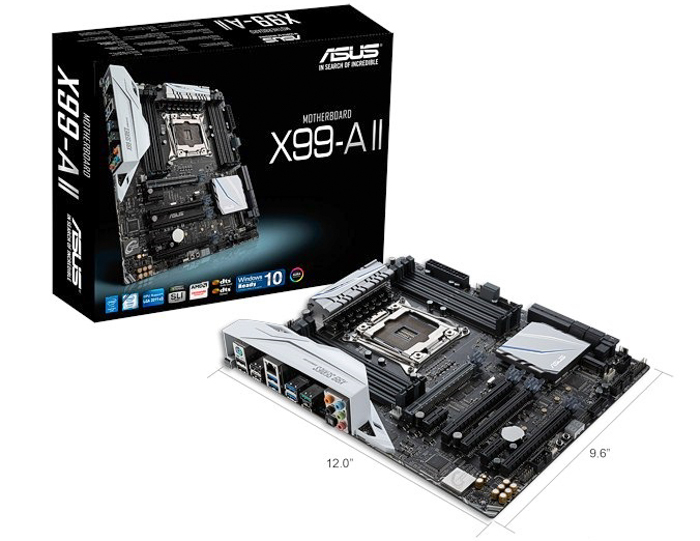
The ASUS X99-A II is a motherboard that the company claims makes “fewer compromises” than the X99-E for a slightly higher price of $249. The slight increase in pricing will result in a header that supports ASUS Aura lighting control on fan headers, PCI-E slot bracket clips, built-in RGB LEDs as well as LED strips connected to the onboard 4-pin RGB header. This board also features a single U.2 slot (32GB/s of bandwidth shared with the M.2 slot) and features both USB 3.1 Type-C and Type-A connectors (the X99-E has a single Type-C connector).
The X99-A II measures 12 inches by 9.6 inches (30.5 x 24.4 centimeters) and supports up to 3-way Nvidia SLI or 3-way AMD CrossFireX. It is fully compatible with existing Haswell-E chips and fully supports upcoming Broadwell-E chips as well.
Specifications on the refreshed mid-range X99-A II include support for up to eight memory modules totaling 128GB of DDR4 at 3333MHz speeds and three PCI-Express 3.0 x16 slots. Other connectivity options include one U.2 slot supporting PCI-E 3.0 x4 AHCI / NVMe drives, another M.2 Socket 3 Type M slot supporting PCI-E 3.0 x4 AHCI / NVMe drives (Note: M.2 shares bandwidth with U.2, only one can be activated at a time), one SATA 3.2 Express 1969MB/s ports, and eight SATA III 6Gbps ports (two shared with SATA Express). Other components include an Intel I218V Gigabit Ethernet controller, an eight-phase digital voltage regulator (VRM) design, a four-phase DRAM VRM design, and onboard power/reset buttons – this last feature is important, as some ASUS motherboards have gone without them.
Regarding the USB input situation – there are two 10Gbps USB 3.1 ports using an ASMedia controller on the back panel (Type-A / Type-C), five USB 3.0 ports controlled by the X99 chipset (one on back panel, four on-board), three USB 3.0 ports using an ASMedia controller (on back panel) and eight USB 2.0 ports controlled by the X99 chipset (four on back panel, four on-board).
In terms of audio, the board includes a Realtek ALC1150 eight-channel audio codec featuring Crystal Sound 3 and uses two separate audio layers on the PCB – separate layers for left and right channels that provide extra interference shielding. The Realtek audio codec features a 112db signal-to-noise ratio (line-out) and 104dB signal-to-noise ratio for stereo input (line-in) along with DTS Connect, DTS Surround Sound. The board also features an optical port on the back panel and uses high-quality premium Japanese capacitors, includes an EMI shield and has a unique “de-pop” circuit that reduces start-up popping noise on audio output signals.
More specific ASUS technologies available with this board include ASUS LANGuard (2.5 times higher surge tolerance), Aura RGB lighting control, ASUS Q-LED and ASUS Fan Xpert 4 for fine-tuning and fan adjustments.
The ASUS X99-A II is priced at $249, right above the X99-E ($219) yet below the Sabertooth X99 ($299). It is not yet available as of launch date but is expected to arrive in retail channels before the end of the month.
X99-Deluxe II: “When only the best will do”
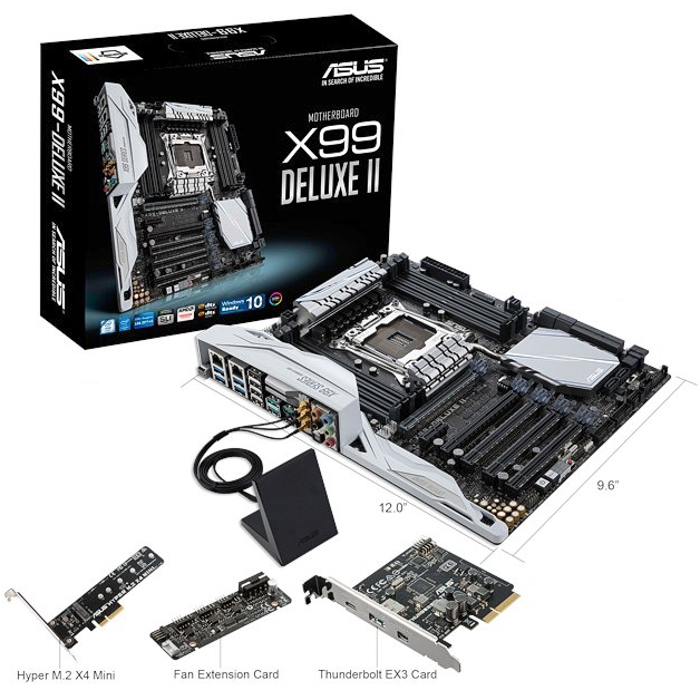
The company’s latest flagship board for 2016 is the X99 Deluxe II, a refreshed Signature series board that features more upgrades in the networking department than any other area, along with support for 4-way SLI and 4-way CrossFireX. We are talking about two Intel Gigabit Ethernet controllers, dual-band Wi-Fi featuring 3 x 3 MU-MIMO support and Bluetooth 4.1. Other noticeable upgrades include dual U.2 slots (to offload SSD temperatures away from motherboard) along with a single M.2 slot, a Fan Extension card with three more fan headers and three more thermal probes (bringing the total to nine), and a low-profile HyperX M.2 card that mounts M.2 SSDs vertically rather than on-board for more efficient heat dissipation.
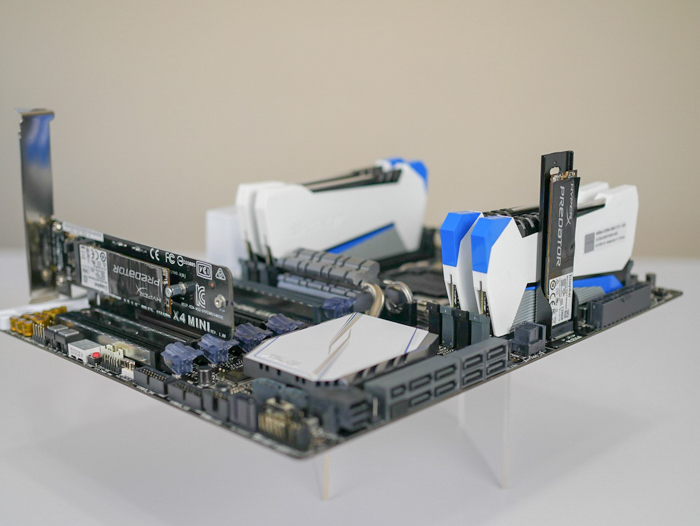
ASUS X99 Deluxe II motherboard with HyperX M.2 PCI-E 3.0 x4 add-in card and a vertically-mounted HyperX M.2 PCI-E 3.0 x4 SSD
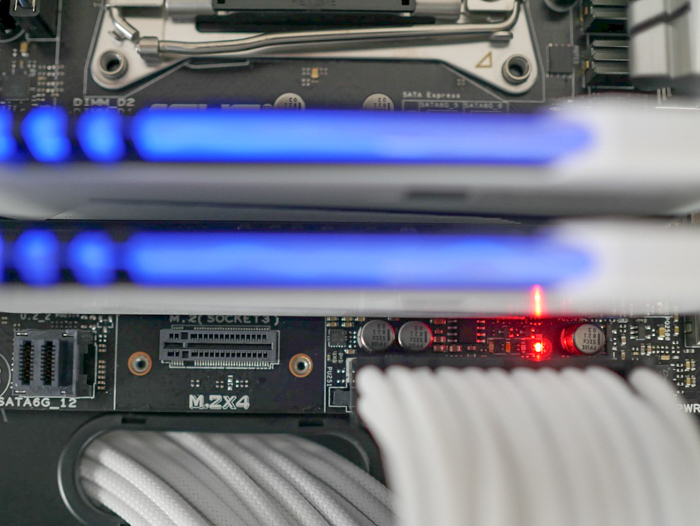
ASUS X99 Deluxe II, just like the original X99 Deluxe, features a vertical M.2 PCI-E 3.0 x4 slot for additional heat dissipation
Last but not least, the high-end X99 Deluxe II also bundles an ASUS ThunderboltEX 3 add-in card in the box. This card is based on Intel’s Alpine Ridge controller and offers bidirectional speeds up to 40Gbps (four times the bandwidth of USB 3.1). It is also capable of sharing this bandwidth with up to 6 daisy-chained monitors and devices (up to 5K at 60Hz). The ThunderBolt EX3 add-in card also provides up to 36W of power to fast-charging USB devices.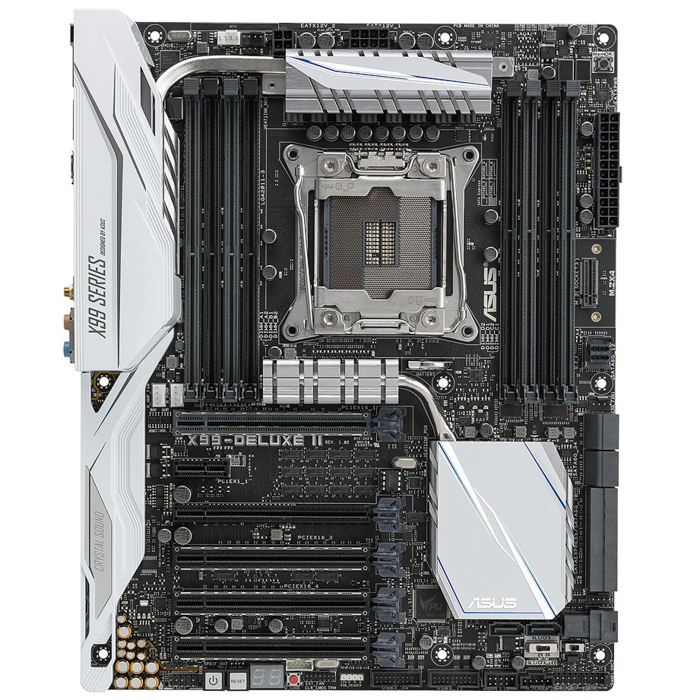
The X99 Deluxe II measures 12 inches by 9.6 inches (30.5 x 24.4 centimeters) and supports up to 4-way Nvidia SLI or 4-way AMD CrossFireX. This can be achieved using a x8/x8/x8/x8 bandwidth configuration across all four PCI-Express 3.0 slots (7.88GB/s each). The board is fully compatible with existing Haswell-E chips and fully supports upcoming Broadwell-E chips as well.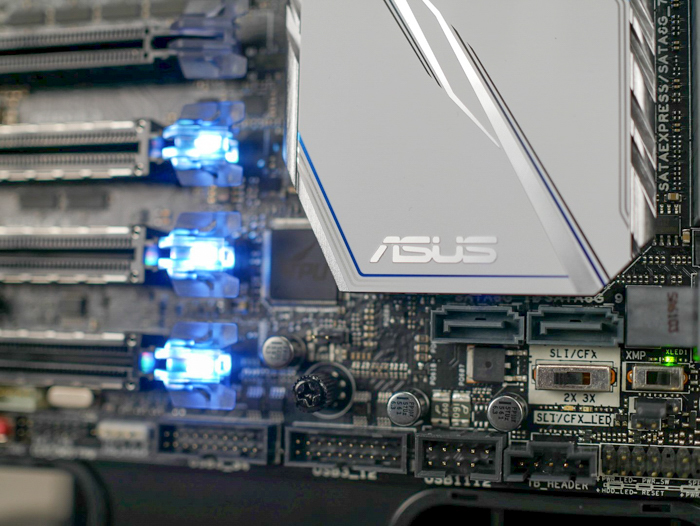
Specifications on the refreshed high-end X99 Deluxe II include support for up to eight memory modules totaling 128GB of DDR4 at 3333MHz speeds and four PCI-Express 3.0 slots (single x16, dual x16/x16, triple x16x16/x8 or quad x8/x8/x8/x8). Other connectivity options include two U.2 slots supporting PCI-E 3.0 x4 AHCI / NVMe drives, another M.2 Socket 3 Type M slot supporting PCI-E 3.0 x4 AHCI / NVMe drives (Note: M.2 shares bandwidth with U.2, only one can be activated at a time), one SATA 3.2 Express 1969MB/s port, and eight SATA III 6Gbps ports (two shared with SATA Express).
Networking features include dual Intel Gigabit Ethernet controllers (Intel I218V and Intel I211-AT) supporting teaming and ASUS Turbo LAN, 802.11n/ac Wi-Fi with MU-MIMO support, and Bluetooth 4.1. The board uses an eight-phase digital voltage regulator (VRM) design and also includes an on-board Q-code LED display for a quick view of POST codes, DRAM, VGA and CPU temperatures, a DirectKey button for instant BIOS access, a 4-pin water pump header, a 4-pin Aura RGB header for custom lighting control – and on-board power and reset buttons.

Regarding the USB input situation – there are four 10Gbps USB 3.1 ports all using ASMedia controllers on the back panel (three Type-A ports, one Type-C port), four USB 3.0 ports controlled by the X99 chipset (all on back panel), and four USB 2.0 ports controlled by the X99 chipset (all on back panel) with one switchable to USB BIOS Flashback.
In terms of audio, the board includes a Realtek ALC1150 eight-channel audio codec featuring Crystal Sound 3 and uses two separate audio layers on the PCB – separate layers for left and right channels that provide extra interference shielding. The Realtek audio codec features a 112db signal-to-noise ratio (line-out) and 104dB signal-to-noise ratio for stereo input (line-in) along with DTS Connect, DTS Studio Sound and Absolute Pitch 192KHz, 24-bit True Blu-ray Disc Lossless Sound. The board also features an optical port on the back panel and uses high-quality premium Japanese capacitors, includes an EMI shield and has a unique “de-pop” circuit that reduces start-up popping noise on audio output signals.
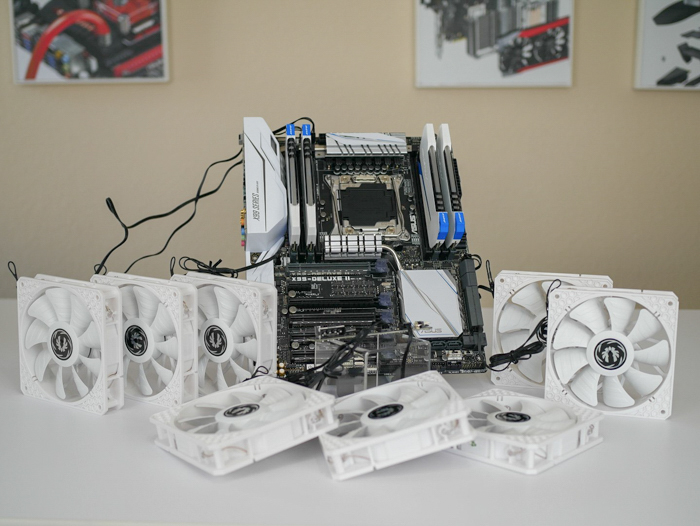
The ASUS X99 Deluxe II, when used with the Fan Extension card, features up to nine fan headers (eight + CPU)
The ASUS X99 Deluxe II is priced at $419 – above the ROG Strix X99 Gaming ($339) and below the X99 Rampage V Extreme ($479). It is not yet available as of launch date but is expected to arrive in retail channels before the end of the month.
Additional pictures and information
ASUS Senior Technical Marketing Specialist J.J. Guerrero posted some additional pictures of the new ASUS X99 Deluxe II on Google+ which can be found here.
More details on the differences between the company's new and refreshed X99 motherboards, including the question of “which one should I buy?” are all explained in an official ASUS blog post here.

